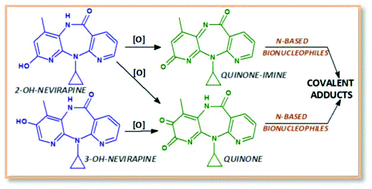Quinoid derivatives of the nevirapine metabolites 2-hydroxy- and 3-hydroxy-nevirapine: activation pathway to amino acid adducts†
Abstract
Nevirapine (NVP) is the non-nucleoside HIV-1 reverse transcriptase inhibitor most commonly used in developing countries, both as a component of combined antiretroviral therapy and to prevent mother-to-child transmission of the virus; however, severe hepatotoxicity and serious adverse cutaneous effects raise concerns about its safety. NVP metabolism yields several phenolic derivatives conceivably capable of undergoing further metabolic oxidation to electrophilic quinoid derivatives prone to react with bionucleophiles and initiate toxic responses. We investigated the ability of two phenolic NVP metabolites, 2-hydroxy-NVP and 3-hydroxy-NVP, to undergo oxidation and subsequent reaction with bionucleophiles. Both metabolites yielded the same ring-contraction product upon oxidation with Frémy's salt in aqueous medium. This is consistent with the formation of a 2,3-NVP-quinone intermediate, which upon stabilization by reduction was fully characterized by mass spectrometry and nuclear magnetic resonance spectroscopy. Additionally, we established that the oxidative activation of 2-hydroxy-NVP involved the transient formation of both the quinone and a quinone-imine, whereas 3-hydroxy-NVP was selectively converted into 2,3-NVP-quinone. The oxidations of 2-hydroxy-NVP and 3-hydroxy-NVP in the presence of the model amino acids ethyl valinate (to mimic the highly reactive N-terminal valine of hemoglobin) and N-acetylcysteine were also investigated. Ethyl valinate reacted with both 2,3-NVP-quinone and NVP-quinone-imine, yielding covalent adducts. By contrast, neither 2,3-NVP-quinone nor NVP-derived quinone-imine reacted with N-acetylcysteine. The product profile observed upon Frémy's salt oxidation of 2-hydroxy-NVP in the presence of ethyl valinate was replicated with myeloperoxidase-mediated oxidation. Additionally, tyrosinase-mediated oxidations selectively yielded 2,3-NVP-quinone-derived products, while quinone-imine-derived products were obtained upon lactoperoxidase catalysis. These observations suggest that the metabolic conversion of phenolic NVP metabolites into quinoid electrophiles is biologically plausible. Moreover, the lack of reaction with sulfhydryl groups might hamper the in vivo detoxification of NVP-derived quinone and quinone-imine metabolites via glutathione conjugation. As a result, these metabolites could be available for reaction with nitrogen-based bionucleophiles (e.g., lysine residues of proteins) ultimately eliciting toxic events.


 Please wait while we load your content...
Please wait while we load your content...